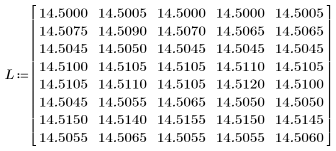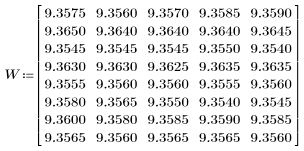Example: Determining Optimal Conditions
Use the taguchi function to create a Taguchi experiment and use effects plots to determine the best conditions for a manufacture process.
In an experiment to improve the injection of molded plastic, the following factors are identified to be potentially significant:
• IV—Injection Velocity
• CT—Cooling Time
• BZ—Barrel Zone temperatures
• MT—Mold Temperature
• HP—Hold Pressure
• BP—Back Pressure
1. Call taguchi to create a design matrix from one of available Taguchi designs. Choose the design with 7 factors of 2 levels.

2. Determine a low and a high level for each of the six factors. Use the seventh factor to estimate the error in the measurements.

3. Call doelabel to view the design matrix with the real values of the factor levels instead of their coded values.

4. Record the length of the mold in matrix L when the width is held at 9.380 cm. Matrix L has one row per run and one column per replicate.

5. Create an effects plot to view how the factors influence the length of the molded plastic.




The desired length is 14.500cm, so setting the factors IV, CT, and HP to their low levels increases the chance to reach the desired length. The factors BZ, MT, and BP are not significant in determining the length of the molded plastic.
6. Record the width of the mold in matrix W when the length is held at 14.500cm.

7. Create an effects plot to view how the factors influence the width of the molded plastic.



The desired width is 9.380cm, so setting the factors IV and BZ to their low levels, and the factors MT and HP to their high levels increases the chance to reach the desired width. The factors CT and BP are not significant in determining the width of the molded plastic. The only factor which is in conflict between the first and second set of data is HP which is best at its low level to reach the desired length and at its high level to reach the desired width.
Carry out verification runs at the best conditions predicted by this experiment (IV: low, CT: high, BZ; low, MT: low). Set HP to its high level as it has greater influence on width than on length. The factor BP has little impact on the result. You can set this factor to its low level.
Reference
Schmidt, S. and Launsby, R., Understanding Industrial Designed Experiments, Colorado Springs: Air Academy Press & Associates, 1994, pp. 8–23